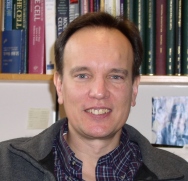Richard Wozniak

Richard Wozniak
Ph.D., Rockefeller University
Professor
Office: 6-51B Medical Sciences BuildingLaboratory: 6-51 Medical Sciences Building
Telephone: 780-492-1384
rick.wozniak@ualberta.ca
Awards
- Alberta Innovates - Health Solutions Scientist
- Howard Hughes Medical Institute International Research Scholar
Summary of Research Plan
In all eukaryotic cells, genes are housed in the nucleus. The nucleus segregates the genome away from the surrounding cytoplasm using a double membrane barrier termed the nuclear envelope (NE). For most macromolecules to cross the NE, they require the appropriate transport signals. These signals, through interactions with transport proteins, allow passage across the NE through massive channels termed nuclear pore complexes (NPCs). By regulating what enters or leaves the nucleus, NPCs play a central role in controlling gene expression. In addition, recent evidence from our laboratory and others suggests that NPCs regulate gene expression by directly modulating chromatin structure and the spatial organization of the genome. As these critical functions of NPCs would imply, mutations in components of NPCs are deleterious, and they have been linked to a variety of diseases including Alzheimer's disease, heart disease, and cancer. Moreover, viruses often target NPCs during infection to support their replication.
Over the years, we have made important discoveries describing the structure and function of NPCs in yeast and mammalian cells, and, in the process, we have established collaborations with leading national and international scientists. Building on our previous accomplishments and a strong collaborative network, it is our goal to use state-of-the-art technologies available in yeast and human cell culture systems to examine the role of NPCs as architects of chromatin structure and epigenetic regulators of gene expression. We are using this information to study how altering or compromising NPC function contributes to disease states arising from fungal and viral infections.
Our ongoing research program consists of two general areas of focus. First, we will use yeast and human cell model systems to identify and characterize the molecular interface between NPCs and chromatin. The long-term goals of these studies are to define the contributions of NPCs to the assembly and modulation of chromatin structure, and to define the function of NPCs in the transmission of the epigenetic features to daughter cells. An important byproduct of this research will be an understanding of the role of NPCs in regulating the expression of virulence genes in pathogenic yeast, and the potential to exploit this mechanistic information for the purpose of developing novel approaches to treating fungal diseases.
Finally, we have developed a collaborative network to explore the role of NPC proteins in viral infections. In the initial stages of this work, we showed that infection with plus-strand RNA viruses (including hepatitis A and C, Dengue, and Zika) causes redistribution of several NPC proteins to cytoplasmic membranes where we propose they contribute to the compartmentalization of viral replication. We also hypothesize that this redistribution of NPC proteins alters their canonical functions, including their ability to regulate host cell gene expression. Through an investigation of interactions between viral and NPC proteins, we predict this work will identify NPC proteins commonly targeted by plus-strand RNA viruses, offering the potential for the development of inhibitors with broad-spectrum antiviral activity.
Selected Publications
Lapetina, D. L., C. Ptak, U. K. Roesner, and R. W. Wozniak. (2017). Yeast Sir4 and a subset of nucleoporins form a complex distinct from nuclear pore complexes. J Cell Biol. 216:3145-3159.
Capitanio, J.S., B. Montpetit, and R. W. Wozniak. (2017). Human Nup98 regulates the localization and activity of DExH/D-box helicase DHX9. e-Life. 6:e18825.
Ptak, C. and R. W. Wozniak. (2016). Nucleoporins and chromatin metabolism. Curr Opin Cell Biol. 40:153-160.
Cairo, L. V. and R.W. Wozniak. (2016). The nuclear transport factor Kap121 is required for stability of the Dam1 complex and mitotic kinetochore bi-orientation. Cell Reports. Mar 15;14(10):2440-50.
Neufeldt C. J., M.A. Joyce, N.V. Buuren, K. Kirkegaard., A. Levin, M. Gale, L.J. Tyrrell, and R.W. Wozniak (2016). The hepatitis C virus-induced membranous web and associated nuclear transport machinery limit access of pattern recognition receptors to viral replication sites. PLOS Pathogens. Feb 10;12(2):e1005428.
Levin A, C.J. Neufeldt, D. Pang, K. Wilson, D. Loewen-Dobler, M.A. Joyce, R.W. Wozniak, D.L. Tyrrell. (2014). Functional characterization of nuclear localization and export signals in hepatitis C virus proteins and their role in the membranous web. PLoS One. Dec 8;9(12):e114629. doi: 10.1371/journal.pone.0114629.
Ptak, C. and R.W. Wozniak. (2014). Assessing Nuclear Transport in Saccharomyces cerevisiae. Methods Cell Biol. 122:311-30.
Ptak, C., J. D. Aitchison, and R. W. Wozniak. (2014). The multifunctional nuclear pore complex: a platform for controlling gene expression. Curr Opin Cell Biol. 20;28C:46-53.
Makio, T., D. L. Lapetina, and R. W. Wozniak. (2013). Inheritance of yeast nuclear pore complexes requires the Nsp1p-containing subcomplex. J Cell Biol. 203:187-96.
Cairo, L. V., C. Ptak, and R.W. Wozniak. (2013). Dual personality of Mad1: Regulation of nuclear import by a spindle assembly checkpoint protein. Nucleus. 4:367-373.
Neufeldt, C. J., M. A. Joyce, A. Levin, R. H. Steenbergen, D. Pang, J. Shields, D. L. J. Tyrrell, and R. W. Wozniak. (2013). Hepatitis C virus-induced cytoplasmic organelles use the nuclear transport machinery to establish an environment conducive to virus replication. PLOS Pathogens. Oct;9(10):e1003744. Epub 2013 Oct 31.
Van de Vosse, D. W., Y. Wan, D. Lapetina, D. Chen, J-H. Chiang, J. D. Aitchison, and R. W. Wozniak. (2013). A role for the nucleoporin Nup170p in chromatin structure and gene silencing. Cell. 152:969-983.
Cairo, L. V., C. Ptak, and R. W. Wozniak. (2013). Mitotic-specific regulation of nuclear transport by the spindle assembly checkpoint protein Mad1p. Mol. Cell. 49:109-20.
Laboratory Members
Graduate Students
Nicole Love
Saif Rehman
Natasha Saik
Research Associates
Dr. Tadashi Makio
Dr. Chris Ptak